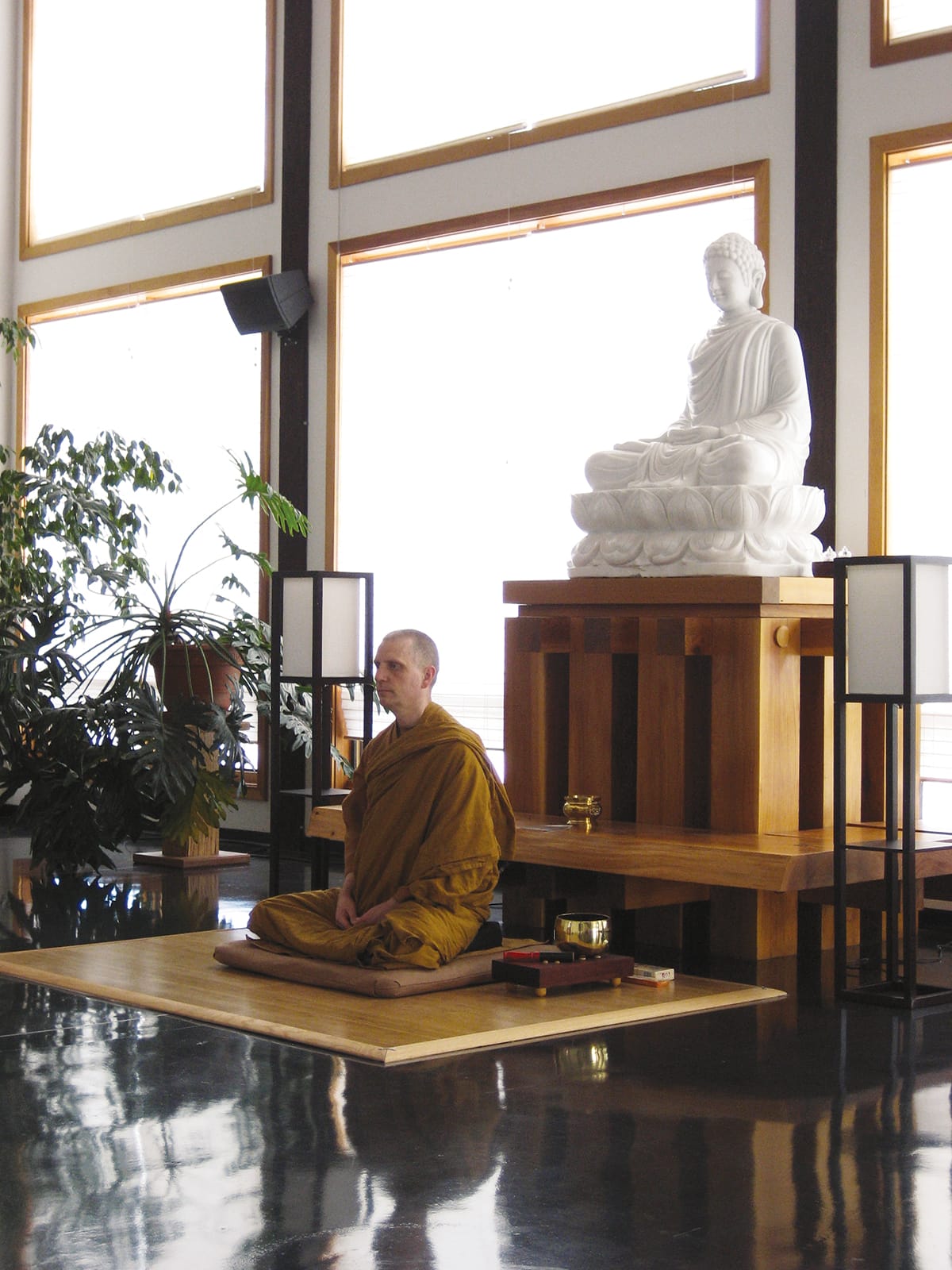Tom West is now Bhikkhu Sona, the abbot of Canada’s first Buddhist monastery in the Thai Forest tradition, Birken Forest Monastery, located in British Columbia. And though he’s dedicated himself to a monastic life, he has not lost any of his ecological zeal, which is clearly evident in the monastery’s sound ecological design.
Bhikkhu Sona began work on Birken in 1994, at the age of 40, after returning from Thailand, where he spent three years training in monasteries, including Ajahn Chah’s Wat Pah Nanachat. In the early days, Birken was just a two-room shack located in the mountains near Pemberton, British Columbia, that Bhikkhu Sona shared with fellow monk Bhikkhu Piyadhammo. Despite the remote location, the scavenging bears, and the absence of plumbing, electricity, a phone, and even a sign to point the way, “a certain magic prevailed, and people showed up.” In less than a decade, in fact, their supporters ballooned from a handful to hundreds, then thousands.
The shack of Birken I gradually transformed into Birken II, featuring running water, power, a furnace, refrigerator, sink, “and even carpeting.” And finally, the existing monastery, Birken III, was built, nestled on eighty acres of forest and pristine marshland, 4,000 feet up, eight miles from the nearest neighbor, with room for twenty-five residents and guests—all sustained by “good-hearted, unsolicited donations.”
“You can talk till you’re blue in the face, but when a person lives a certain way, it’s very effective,” says Bhikkhu Sona. “That’s what inspires people, if you actually do it.”
“Doing it,” in the case of Birken Forest Monastery, has required thousands of person hours, largely voluntary, from countless lay supporters and numerous monks. Among the men in robes who have labored to dig drainage ditches, stack plywood, install siding, and pour concrete have been Bhikkhu Thitapuñño, a post-doctoral research chemist; Bhikkhu Nanda, a highly accomplished self-made businessman; and Bhikkhu Pavaro, a Ph.D. and former professor of religious studies.
“These guys are very competent people, as good as you could possibly get,” says Sona of his “monks of all trades.” He adds, “We’re entirely capable of making our own livings. We voluntarily do this.”
Today, the main residence provides nearly 10,000 sq. ft. of living space, including a beautiful meditation hall that overlooks the surrounding forest. The vaulted ceiling of the sala is thirty feet high, and behind the sitting Buddha rises a floor-to-ceiling wall of glass. Outdoors, seasonal variations are extreme, with temperatures ranging from summer highs of 100°F (38°C) to -40°F (-40°C) in winter, while inside the mix of ceiling fans and radiant floor heating keeps the atmosphere consistently comfortable. It’s a far cry from the “shack days,” when keeping warm could mean tearing apart an old box spring mattress for firewood.
The monks themselves live in kutis, single-occupant huts spread out among the surrounding bushes and trees. Living conditions for them are considerably more spartan than they are for guests, with neither plumbing nor electricity. Ubiquitous in various regions of South Asia, these traditional dwellings have a maximum size of roughly one hundred square feet, specified by the Buddha himself to ensure that his followers would not become a burden on the laity.
Remarkably, the monastery is now completely “off the grid,” Bhikkhu Sona reports. Sixteen solar panels supply enough electricity to meet most requirements for most of the year. On cloudy days and in the winter, supplemental power is provided as needed by a backup diesel generator. Both sources feed through state-of-the-art inverters to an array of deep pile batteries, producing a standing capacity of 60 kilowatts. This takes care of all needs, he notes, “including pumping up our own water out of the well, all the lights, all the appliances—washers, driers, freezer, fridge, bread maker, microwave, computers.”
There’s an obvious excitement in Sona’s body language as he ticks off the particulars, comparing current energy consumption to the on-the-grid record of Birken II: “Six to twelve times less, with more than double the space and population!” BTUs and kilowatt-hours roll off this abbot’s tongue as fluidly as abstruse metaphysical concepts.
All the Buddhist precepts have influenced the achievement, explains Bhikkhu Sona, harking back to ancient times for examples of environmental awareness in monastic lifestyles: robes patched and repatched, then recycled as doormats; toothbrushes made of biodegradable cane; fifth-century BCE latrines with filtering systems of sand, charcoal, and incense-scented clay.
Birken III, with its wood-burning water boiler, its recycling at source, and its refrigerator run on the power of a 40 watt light bulb, actively continues the tradition. “We mow our lawn with sunlight!” exclaims Bhikkhu Sona. “Electric shaver, electric hair trimmer—I cut my hair with sunlight!
There is a kind of magic in the air at moments like this; a tantalizing sense of defying gravity—as if simply believing in sustainable ways of living were enough to make them real. Has it not already happened here, far from the global marketplace, where this unlikely venture flourishes? “Our little commune is, frankly, a miracle,” Sona observes. It is also a vindication, for him, of the “uncanny wisdom” of the Teacher he describes as “the most sophisticated thinker in history,” who could also easily qualify as the “first environmentalist.”
Last fall, Bhikkhu Sona changed the monastery’s name to Sitavana, a Pali word meaning “cool forest”—a fitting name for this welcome retreat in the woods. From its earth-toned buildings to gleaming solar panels, everything about it serves to honor and enhance the natural stillness, cultivating, as Bhikkhu Sona describes it, “that most refined of tastes, the taste for silence; the flavor that makes everything else fall into place.”
